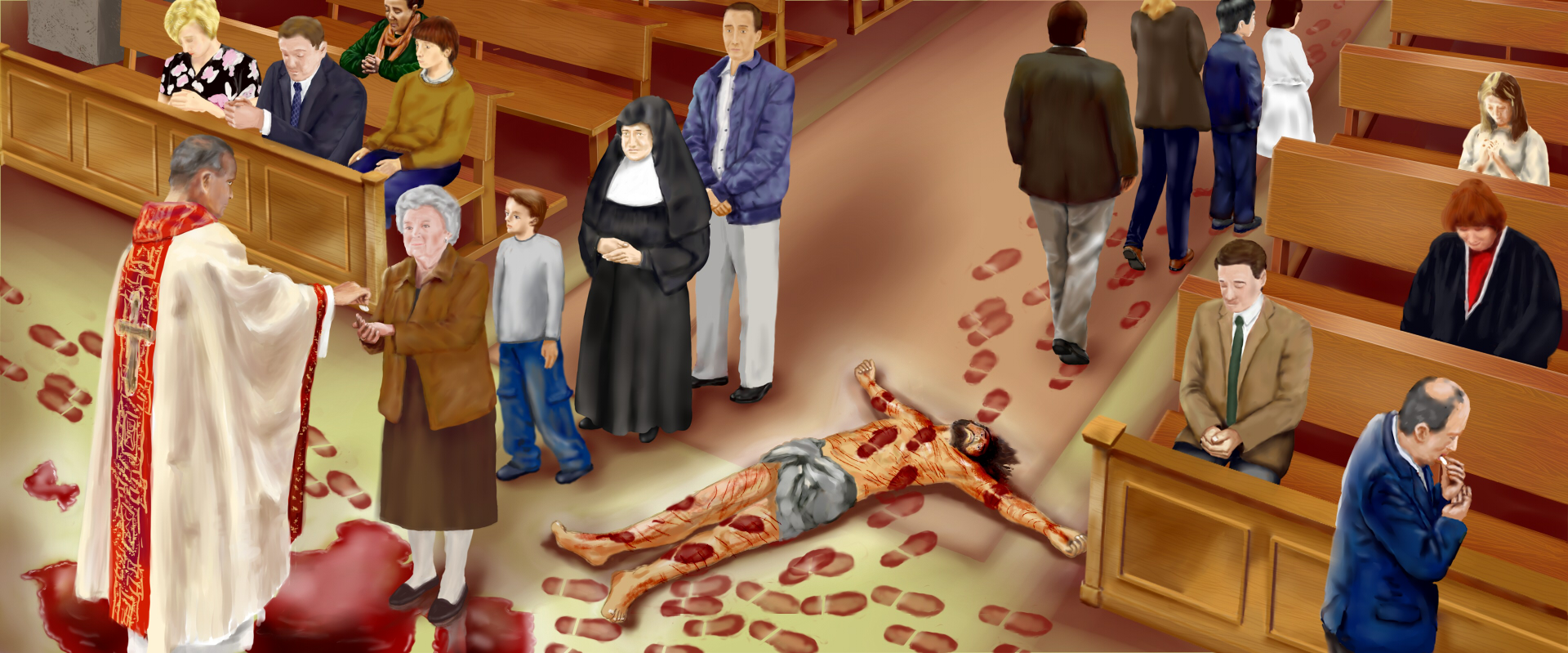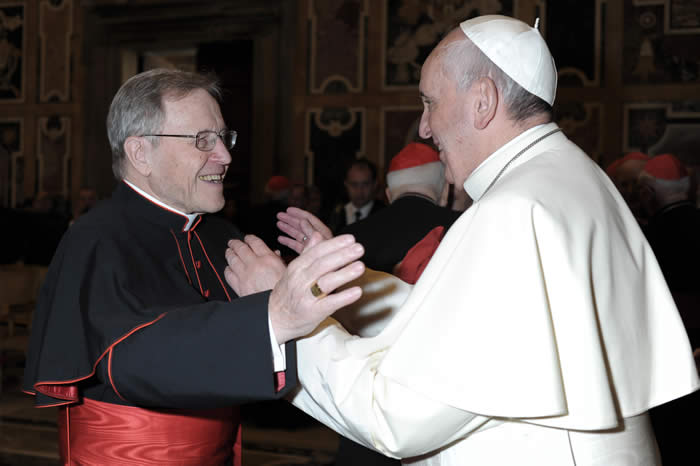Remnant Articles

When Tertullian wrote, probably in the late second century, that the blood of the martyrs is the seed of the Church, the images in his mind, of bloodied, dismembered, mangled, and maimed Christian bodies subjected to persecution and put to death for the sake of Christ, were likely little different from those that crowd into our own minds today.
Turn where you will, you will find men and women crucified, beheaded, blinded, burned, imprisoned, and impaled—the Church Militant here below shading awfully, and yet supernaturally, into the Church Suffering above.
I have received a letter from Christopher A. Ferrara–an attorney for The Remnant which says:Readers may recall Fr. Dwight Longenecker’s unprovoked attack on traditional Catholics last month in an article entitled “Ten Traits of Catholic Fundamentalism” (Patheos.com). In the wake of that article, The Remnant issued a demand for public retraction from Fr. Longenecker.
"Accordingly, I hereby demand that within five days of the date of this letter you publish on your website, with as much prominence as the original article, your full and unequivocal retraction of the statements 'given enough rope they will move from verbal violence to physical violence' and 'given enough rope they will move from verbal violence to personal violence' as they apply to the Remnant its Editor and his associates."
In compliance with Mr Ferrara’s request I retract fully, unequivocally and completely any statement or suggestion that Mr Matt, The Remnant staff, readers and associates might tend towards violence of any kind, nor would they ever threaten anybody."
- Fr. Dwight Longenecker, March 31, 2016

Translated for The Remnant by Carolina Santos
“If anyone denies that in the venerable sacrament of the Eucharist the whole Christ is contained under each form and under every part of each form when separated, let him be anathema.” … Council of Trent
I have been observing discussions about the topic of “communion in the hand.” In all of them I notice a set of arguments frequently made by the laity and the clergy alike, some justifying the reception of communion in the hand, others the administration of it, which shows that, despite their good intentions, they do not understand the true nature of the problem at hand.
Communion in the Hand: The Floor Is Stained with His Blood
By: Miguel Ángel Yáñez, Spain Correspondent
Brothers-in-Arms: Cardinal Kasper and Pope Francis the Great
Editor's Note: This article first appeared in the November 15, 2014 issue of The Remnant but it is no less relevant today, with reports now surfacing that Pope Francis signed the Apostolic Post-Synod on the Family Exhortation on the Feast of St. Joseph, March 19, and that it is scheduled to be released shortly after Easter. According to a report in Corriere della Sera of March 20th, the exhortation "will include many innovative practical choices regarding marriage preparation and couples in irregular situations: not only for the divorced and remarried but also for cohabiters, marriages with a believer and non-believer and for those only civilly-married.” May God help us all. MJM
Question: Can we expect spirited resistance from our favorite Neo-Catholic commentators against whatever shenanigans Kasper and company decide to pull with Francis’ approval at next year's Synod on the Family? No! Why? Because in principle, they have already hitched their intellectual wagons to the Kasper train.

Why do the ungodly hate believers so much? Because anyone who asserts that there was a Man who came back from the dead, and that following and obeying Him will lead us out of the grave, is a rebuke to them.
Sometimes the Bible is useful for more than just incensing at Mass.
In his homily on Ps. 63 that is set as the reading for the second Nocturn of Matins for Good Friday, St. Augustine tells us the reason the Pharisees and leaders of the Temple hated Jesus and wanted him dead.
Hatred, Wisdom and Easter: What’s the Connection? Featured
Written by Hilary White
“Hail Cross! Thou only hope of man. During this Passiontide increase the grace of the pious and purge sinners from their guilt.” (Vexilla Regis.)
The first four weeks of Lent were but a preparation for the intense grief of the Church during the final two. She knows that the enemies of Jesus seek His death and will lay their sacrilegious hands upon Him within twelve days. She asks us to climb the hill of Calvary with Him; to witness His Passion and death; to see the stone placed against the Sepulcher where His lifeless body is laid.

The CONSECRATION: Last Supper and Calvary
In Nomine Patris, et Filii, et Spiritus Sancti. Amen.
The “Lord’s Supper” was a Biblical term adopted during the Protestant ‘De’-formation of the Church to deny the Sacrificial nature of the Mass and to replace it with a simple “memorial.” Protestants and Modernists* endeavor to separate the Christ-centered Sacrifice at Calvary from the Holy Sacrifice of the Mass, turning a solemn event into a community-centered “happy meal.” However, Sacred Scripture and Sacred Tradition both affirm that Calvary was omnipresent in the very First Mass ever offered. That First Mass in the Upper Room was the Last Supper in which Our Lord and God, Jesus Christ, anticipated His Salvific Death on Calvary. [*See the Encyclical Pascendi Dominici Gregis (39) where Pope Saint Pius X defines Modernism as “the synthesis of all heresies.”]
A Holy Week Reflection on the Traditional Latin Mass Featured
By: Father Ladis J. CizikAvvenire, the newspaper of the Italian bishops’ conference, has just publisheda previously unpublished interview of Benedict XVI in October of last year by the liberal Jesuit theologian (forgive the redundancy) Jacques Servais, a leading exponent of the Nouvelle Théologie once suppressed by Rome. Servais is an avid promoter of Hans Urs (“Dare We Hope that All Men Be Saved?”) von Balthasar, who dropped dead days before John Paul II could accomplish the indignity of making him a cardinal.
Benedict Breaks His Silence... with another Leaky Lifeboat Featured
By: Christopher A. FerraraThat is what the motu proprio “Summorum Pontificum” felt like in 2007. It seemed like a lifeline for Tradition and the traditional Mass. Suddenly we could breathe again and it seemed like Tradition was saved from certain death. We, understandably, felt relieved and grateful.
(Ooo, scary! Sounds like something right out of the Southern Poverty Law Center’s “Intelligence Report”. Let’s do backflips now to show our jailors how anti-fundamentalist and reasonable we all are.)
With life in an increasingly Christophobic world going from bad to apocalyptic, one wonders what motivates a relatively orthodox Catholic priest to wake up one morning and say: Today I think I’ll launch an Internet attack against all the traditional Catholics in the world.
The Remnant Demands a Retraction from Fr. Longenecker Featured
By: Michael J. Matt | EditorDerived from the Greek root demos, meaning “the people,” demotic is a rich word that denotes or connotes all of the following: common, vulgar, popular, colloquial, the language of ordinary people, demagogic.
Francis is the first designedly demotic Pope in Church history. Unlike any Pope before him, he basks in the world’s unending praise precisely because he styles himself “the people’s Pope.” The world loves “the people’s Pope” for saying what the people want to hear as opposed to what the Church teaches in calling all men to be elevated from their fallen condition through the operation of sanctifying grace and the conformity of nations, laws and institutions to the Law of the Gospel and the Social Kingship of Christ. The disciples who abandoned Our Lord when He revealed the meaning of the Holy Eucharist declared: “This saying is hard, and who can hear it?” But so often when Francis speaks the world delights in replying: “This saying is easy, who can reject it?”





